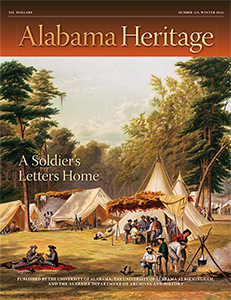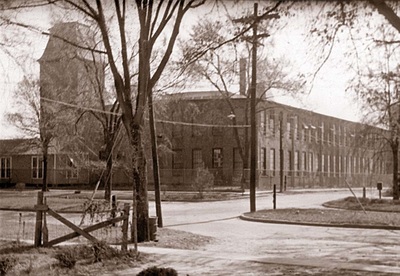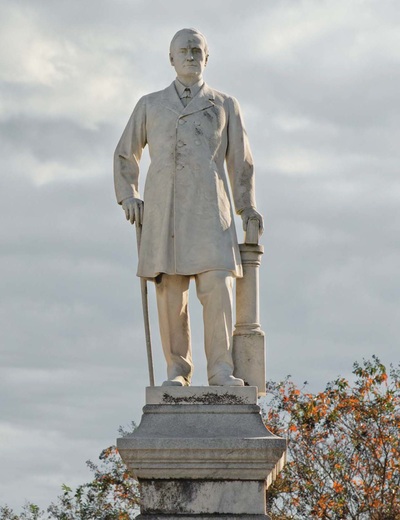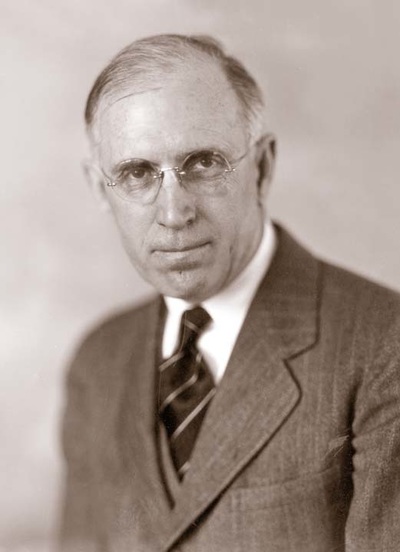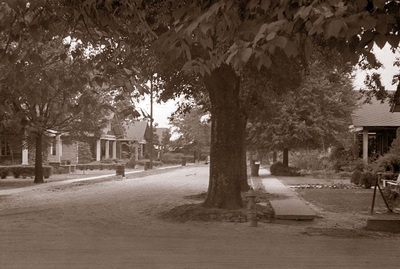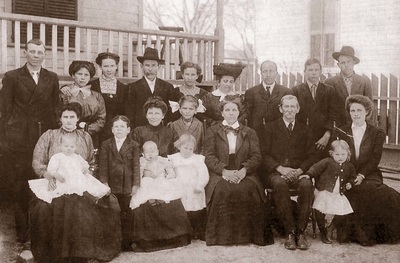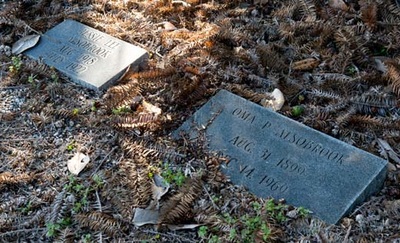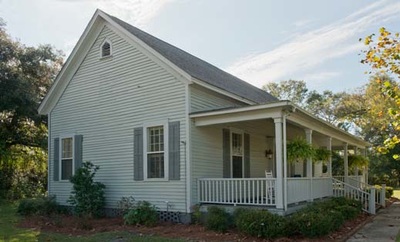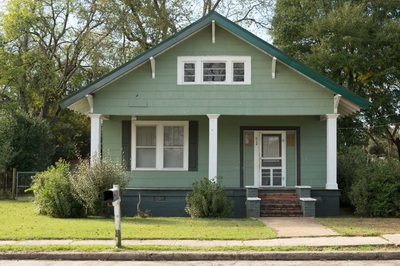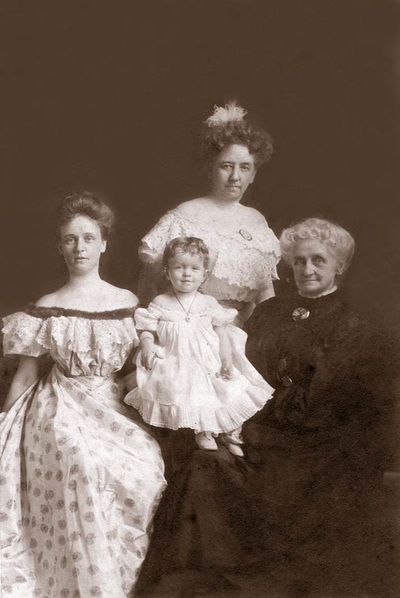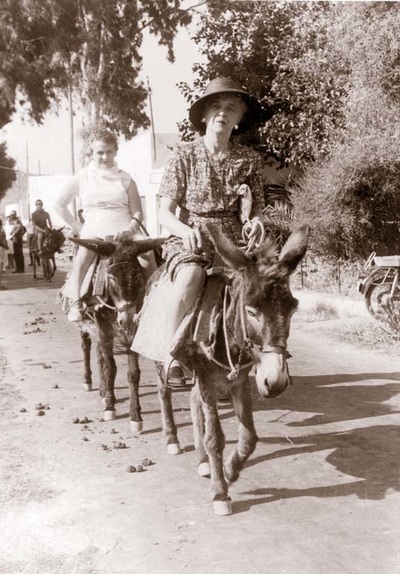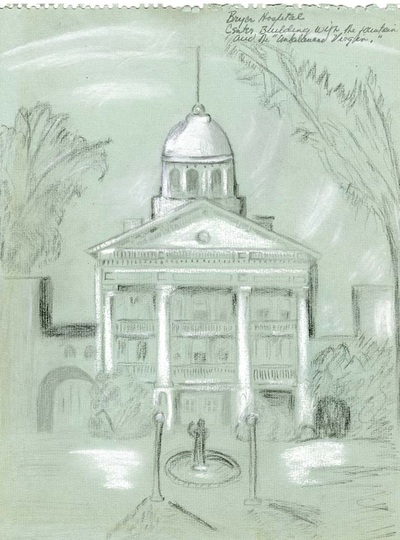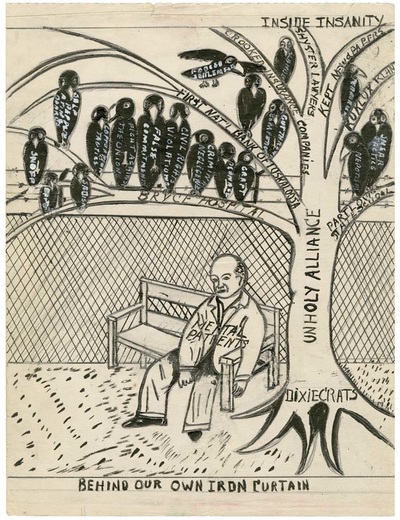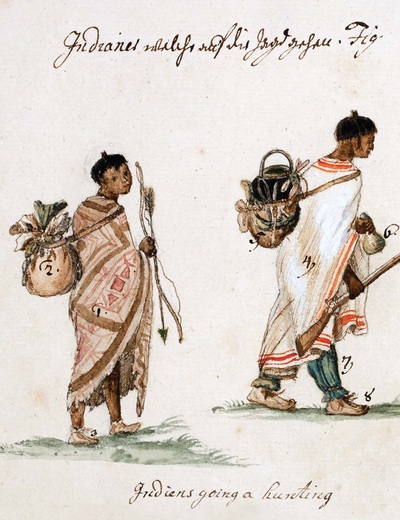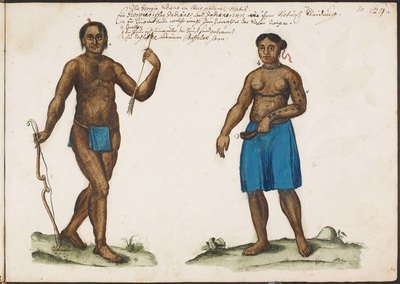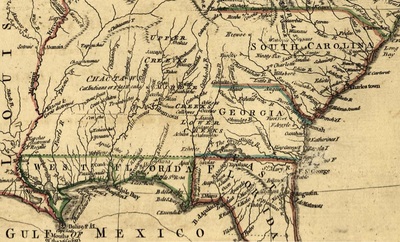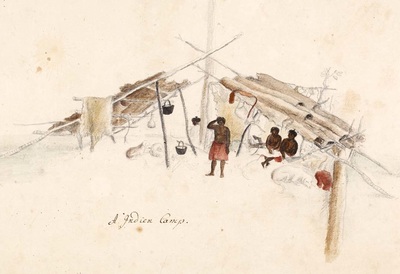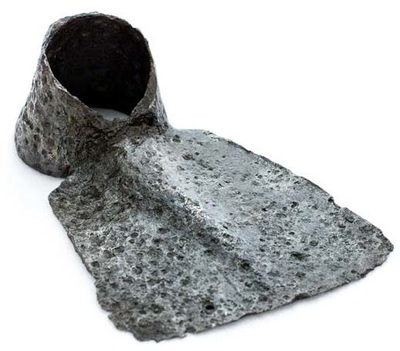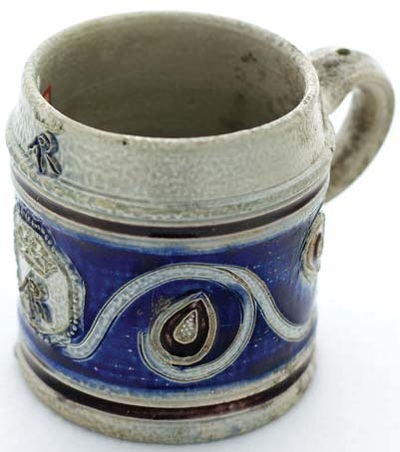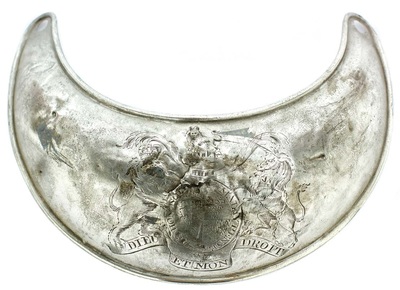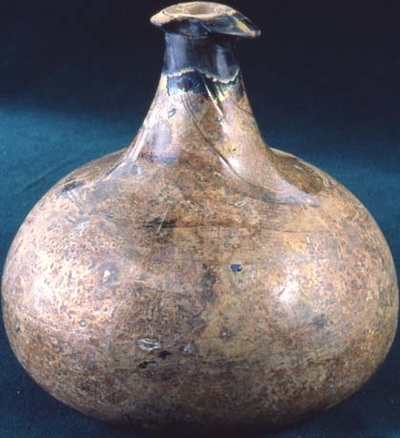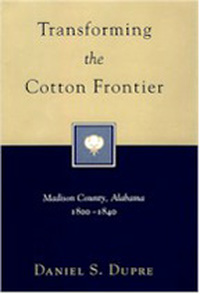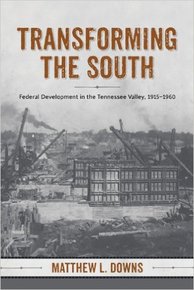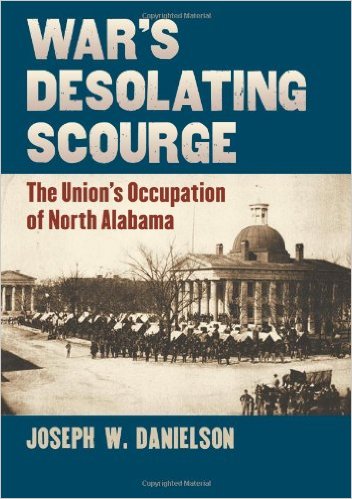|
On the cover: An idealized view of a Confederate army camp, print after a painting (detail) by C.W. Chapman, Fifty-ninth Virginia Regiment. See “Dear Bettie: Letters from a Homesick Alabamian in the Army of Tennessee” by Christopher Thrasher. (Library of Congress)
|
FEATURE ABSTRACTS
“Dear Bettie: Letters from a Homesick Alabamian in the Army of Tennessee”
By Christopher Thrasher
The letters John Crittenden sent his wife Bettie during his deployment in the Army of Tennessee while fighting in the Civil War offer an insightful and poignant glimpse into the hardships endured by soldiers. Crittenden’s letters explain his wartime service, the different parts of Alabama he saw during his tour, the scarcity of wartime resources such as food, and the deep anguish he felt at being separated from his family members. Crittenden wrote Bettie faithfully from the start of his service until the end of his life, and he describes battles throughout the state, including the Battle of Nashville, where Crittenden likely died.
By Christopher Thrasher
The letters John Crittenden sent his wife Bettie during his deployment in the Army of Tennessee while fighting in the Civil War offer an insightful and poignant glimpse into the hardships endured by soldiers. Crittenden’s letters explain his wartime service, the different parts of Alabama he saw during his tour, the scarcity of wartime resources such as food, and the deep anguish he felt at being separated from his family members. Crittenden wrote Bettie faithfully from the start of his service until the end of his life, and he describes battles throughout the state, including the Battle of Nashville, where Crittenden likely died.
About the Author
Christopher Thrasher is a historian and resident of North Alabama. He graduated in 2002 from the University of North Alabama with a bachelor’s degree in history, received an MA in history in 2008 from Middle Tennessee State University, and earned a PhD in history in 2012 from Texas Tech University. He has taught at Wayland Baptist University, Texas Tech University, and the New Mexico Military Institute. He currently serves as an instructor of History at Calhoun Community College in Decatur, Alabama. His first book is titled Fight Sports and American Masculinity: Salvation in Violence from 1607 to the Present (McFarland, 2015).
Additional Information
Suggestions for Further Reading:
For additional information, please consult the following resources.
Christopher Thrasher is a historian and resident of North Alabama. He graduated in 2002 from the University of North Alabama with a bachelor’s degree in history, received an MA in history in 2008 from Middle Tennessee State University, and earned a PhD in history in 2012 from Texas Tech University. He has taught at Wayland Baptist University, Texas Tech University, and the New Mexico Military Institute. He currently serves as an instructor of History at Calhoun Community College in Decatur, Alabama. His first book is titled Fight Sports and American Masculinity: Salvation in Violence from 1607 to the Present (McFarland, 2015).
Additional Information
Suggestions for Further Reading:
- Carpenter, Noel. 2007. A Slight Demonstration: Decatur, October 1864: Clumsy Beginning of Gen. John B. Hood's Tennessee Campaign. Austin, Tex: Legacy Books & Letters.
- Connelly, Thomas Lawrence. 1971. Autumn of Glory; The Army of Tennessee, 1862-1865. Baton Rouge: Louisiana State University Press.
- Daniel, Larry J. 1991. Soldiering in the Army of Tennessee: A Portrait of life in a Confederate Army. Chapel Hill: University of North Carolina Press.
For additional information, please consult the following resources.
- Auburn University Special Collections finding aid for the John Crittenden collection: http://www.lib.auburn.edu/archive/find-aid/765.htm
- Smithsonian’s National Postal Museum article on Civil War letters: http://postalmuseum.si.edu/letterwriting/lw04.html
- Encyclopedia of Alabama article on the Civil War in Alabama: http://www.encyclopediaofalabama.org/article/h-1429
Southside and Eufaula’s Cowikee Mills Village, 1910–1945
By David E. Alsobrook
During the early decades of the twentieth century, the city of Eufaula was largely divided between the northern population and the southern mill communities. Workers at the Cowikee Mills often had positive experiences and felt part of a tight-knit family, spearheaded by the leadership of mill executive Donald Comer, but this camaraderie lapsed in the broader Eufaula community, where mill families were met with prejudice and derision. The advent of World War II helped change these sentiments, as the larger sacrifices on an international scale led to shifting perspectives for people at home.
By David E. Alsobrook
During the early decades of the twentieth century, the city of Eufaula was largely divided between the northern population and the southern mill communities. Workers at the Cowikee Mills often had positive experiences and felt part of a tight-knit family, spearheaded by the leadership of mill executive Donald Comer, but this camaraderie lapsed in the broader Eufaula community, where mill families were met with prejudice and derision. The advent of World War II helped change these sentiments, as the larger sacrifices on an international scale led to shifting perspectives for people at home.
About the Author
David E. Alsobrook, a Eufaula native, spent his formative years in Mobile. He earned a BS and a PhD at Auburn University and an MA at West Virginia University. He taught high school English and history in Eufaula and Theodore, Alabama. He also was an adjunct history instructor at AUM and DeKalb Community College in Atlanta. The first graduate of the Auburn University Archives Training Program, he worked at the Alabama Department of Archives and History and served as a supervisory archivist at the Jimmy Carter Presidential Library and as the first director of the George H. W. Bush and Bill Clinton Presidential Libraries. He retired in 2007 after thirty years’ service with the National Archives. He has published essays and book reviews in various scholarly and popular journals, primarily dealing with race relations, politics, and society in Alabama and the South. His article evolved from his ancestors’ experiences in Eufaula’s cotton mills and the Southside mill village. His book on this topic is scheduled to be published in 2017 by the Mercer University Press.
Additional Information
For more information about Donald Comer, see this article at the Encyclopedia of Alabama website: http://www.encyclopediaofalabama.org/article/h-2616
For more information about Eufaula, see this article at the Encyclopedia of Alabama website: http://www.encyclopediaofalabama.org/article/h-1639
More photos of Cowikee Mills can be seen in the digital collections of the Alabama Department of Archives and History: http://digital.archives.alabama.gov/cdm/search/collection/photo/searchterm/Cowikee
David E. Alsobrook, a Eufaula native, spent his formative years in Mobile. He earned a BS and a PhD at Auburn University and an MA at West Virginia University. He taught high school English and history in Eufaula and Theodore, Alabama. He also was an adjunct history instructor at AUM and DeKalb Community College in Atlanta. The first graduate of the Auburn University Archives Training Program, he worked at the Alabama Department of Archives and History and served as a supervisory archivist at the Jimmy Carter Presidential Library and as the first director of the George H. W. Bush and Bill Clinton Presidential Libraries. He retired in 2007 after thirty years’ service with the National Archives. He has published essays and book reviews in various scholarly and popular journals, primarily dealing with race relations, politics, and society in Alabama and the South. His article evolved from his ancestors’ experiences in Eufaula’s cotton mills and the Southside mill village. His book on this topic is scheduled to be published in 2017 by the Mercer University Press.
Additional Information
For more information about Donald Comer, see this article at the Encyclopedia of Alabama website: http://www.encyclopediaofalabama.org/article/h-2616
For more information about Eufaula, see this article at the Encyclopedia of Alabama website: http://www.encyclopediaofalabama.org/article/h-1639
More photos of Cowikee Mills can be seen in the digital collections of the Alabama Department of Archives and History: http://digital.archives.alabama.gov/cdm/search/collection/photo/searchterm/Cowikee
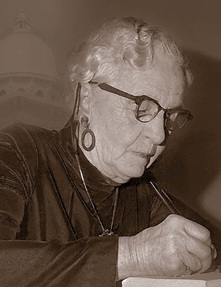 Sara Mayfield was blessed with a wide-ranging intellect and an extraordinary diversity of interests. Even after seventeen years as a patient in Bryce Hospital, she went on to produce work that is still remembered and respected today. (Cynthia Denham; background image of Bryce Hospital: Robin McDonald)
Sara Mayfield was blessed with a wide-ranging intellect and an extraordinary diversity of interests. Even after seventeen years as a patient in Bryce Hospital, she went on to produce work that is still remembered and respected today. (Cynthia Denham; background image of Bryce Hospital: Robin McDonald)
Sara Mayfield: A Woman of Her Times
By Jennifer Horne
From the days of her childhood friendship with Tallulah Bankhead, Zelda Sayre, and Sarah Haardt through her work as a writer and inventor, to her time as a patient at Tuscaloosa’s Bryce Hospital, Sara Mayfield had a wide range of experiences that reflected the concerns and biases of her age. Jennifer Horne explores Mayfield’s Montgomery childhood, education and formative years, and adulthood—marked by moments of insight and creative brilliance, juxtaposed with several stints in mental health institutions. Mayfield’s surprising and circuitous path offers interesting insights into her communities and times.
About the Author
Jennifer Horne teaches in the University of Alabama Honors College. She holds a BA in the humanities from Hendrix College, and an MA in English, an MFA in creative writing, and an MA in community counseling from the University of Alabama. Her published works are Bottle Tree: Poems (WordTech Communications, 2010) and a collection of short stories, Tell the World You’re a Wildflower (University of Alabama Press, 2014), as well as the co-edited volumes All Out of Faith (University of Alabama Press, 2006) and Circling Faith (University of Alabama Press, 2012), and the poetry anthology Working the Dirt (NewSouth, 2003). Her second poetry collection, Little Wanderer, will be published in 2016 by Salmon Poetry, and she is at work on a book about the life of Sara Mayfield. Horne would like to thank Bebe Barefoot, Rachel Dobson, John Crowley, Allan Horne, Don Noble, and Wendy Reed for their valuable suggestions on the writing and revising of this article, and the staff at Hoole for their expert assistance.
By Jennifer Horne
From the days of her childhood friendship with Tallulah Bankhead, Zelda Sayre, and Sarah Haardt through her work as a writer and inventor, to her time as a patient at Tuscaloosa’s Bryce Hospital, Sara Mayfield had a wide range of experiences that reflected the concerns and biases of her age. Jennifer Horne explores Mayfield’s Montgomery childhood, education and formative years, and adulthood—marked by moments of insight and creative brilliance, juxtaposed with several stints in mental health institutions. Mayfield’s surprising and circuitous path offers interesting insights into her communities and times.
About the Author
Jennifer Horne teaches in the University of Alabama Honors College. She holds a BA in the humanities from Hendrix College, and an MA in English, an MFA in creative writing, and an MA in community counseling from the University of Alabama. Her published works are Bottle Tree: Poems (WordTech Communications, 2010) and a collection of short stories, Tell the World You’re a Wildflower (University of Alabama Press, 2014), as well as the co-edited volumes All Out of Faith (University of Alabama Press, 2006) and Circling Faith (University of Alabama Press, 2012), and the poetry anthology Working the Dirt (NewSouth, 2003). Her second poetry collection, Little Wanderer, will be published in 2016 by Salmon Poetry, and she is at work on a book about the life of Sara Mayfield. Horne would like to thank Bebe Barefoot, Rachel Dobson, John Crowley, Allan Horne, Don Noble, and Wendy Reed for their valuable suggestions on the writing and revising of this article, and the staff at Hoole for their expert assistance.
Additional Information
The papers of Sara Mayfield are part of the Hoole Special Collections Library at the University of Alabama. A guide to the papers is available at http://acumen.lib.ua.edu/u0003_0000935
Encyclopedia of Alabama article on Bryce Hospital: http://www.encyclopediaofalabama.org/article/h-1564
Note from the Author
Sara Mayfield’s published works are her biography of H.L. Mencken, The Constant Circle (1969); her biography of F. Scott and Zelda Fitzgerald, Exiles from Paradise (1971); and a historical novel, Mona Lisa (1974). The main primary sources used to research Sara Mayfield’s life were her papers, archived in the W. S. Hoole Special Collections Library at the University of Alabama, and her patient records from Bryce Hospital.
The papers of Sara Mayfield are part of the Hoole Special Collections Library at the University of Alabama. A guide to the papers is available at http://acumen.lib.ua.edu/u0003_0000935
Encyclopedia of Alabama article on Bryce Hospital: http://www.encyclopediaofalabama.org/article/h-1564
Note from the Author
Sara Mayfield’s published works are her biography of H.L. Mencken, The Constant Circle (1969); her biography of F. Scott and Zelda Fitzgerald, Exiles from Paradise (1971); and a historical novel, Mona Lisa (1974). The main primary sources used to research Sara Mayfield’s life were her papers, archived in the W. S. Hoole Special Collections Library at the University of Alabama, and her patient records from Bryce Hospital.
The Creek Indian Deerskin Trade
By Kathryn H. Braund
For Creek Indians in the Alabama Territory, deerskin offered an extremely valuable commodity, becoming their most important trade item in the early nineteenth century. Although this was positive for a time, fostering some relationships between Creeks and Europeans and giving the Creeks access to items they did not have in their own communities, the ongoing practice also introduced changes to the Native Americans’ traditional culture. Over time, deer populations dwindled and Europeans desired other items than deerskins, making even more radical and detrimental changes to Creek communities.
By Kathryn H. Braund
For Creek Indians in the Alabama Territory, deerskin offered an extremely valuable commodity, becoming their most important trade item in the early nineteenth century. Although this was positive for a time, fostering some relationships between Creeks and Europeans and giving the Creeks access to items they did not have in their own communities, the ongoing practice also introduced changes to the Native Americans’ traditional culture. Over time, deer populations dwindled and Europeans desired other items than deerskins, making even more radical and detrimental changes to Creek communities.
About the Author
Kathryn H. Braund is Hollifield Professor of Southern History at Auburn University. She has authored or edited numerous books relating to the Creek Indians. Her first book, Deerskins and Duffels: The Creek Indian Trade with Anglo-America, 1685–1815 (University of Nebraska Press, 1993), was the first to examine the impact of the deerskin trade on all aspects of Creek society. Braund has also published scholarly articles on the southeastern Indians during the American Revolution, Creek gender and work roles, Creek women during the Red Stick war, and slavery among the Creeks. She has edited and annotated the works of three well-known eighteenth-century writers, William Bartram, James Adair, and Bernard Romans. She is also the editor of two collections of essays: Fields of Vision: Essays on the Travels of William Bartram (University of Alabama Press, 2010) and Tohopeka: Rethinking the Creek War (Pebble Hill Books, 2012). She is currently working on a book about the Creek War of 1813–1814.
Additional Information
To find out more about the Creek Indian deerskin trade, see Kathryn Braund’s book Deerskins and Duffels (University of Nebraska Press, second edition, 2008).
Kathryn H. Braund is Hollifield Professor of Southern History at Auburn University. She has authored or edited numerous books relating to the Creek Indians. Her first book, Deerskins and Duffels: The Creek Indian Trade with Anglo-America, 1685–1815 (University of Nebraska Press, 1993), was the first to examine the impact of the deerskin trade on all aspects of Creek society. Braund has also published scholarly articles on the southeastern Indians during the American Revolution, Creek gender and work roles, Creek women during the Red Stick war, and slavery among the Creeks. She has edited and annotated the works of three well-known eighteenth-century writers, William Bartram, James Adair, and Bernard Romans. She is also the editor of two collections of essays: Fields of Vision: Essays on the Travels of William Bartram (University of Alabama Press, 2010) and Tohopeka: Rethinking the Creek War (Pebble Hill Books, 2012). She is currently working on a book about the Creek War of 1813–1814.
Additional Information
To find out more about the Creek Indian deerskin trade, see Kathryn Braund’s book Deerskins and Duffels (University of Nebraska Press, second edition, 2008).
DEPARTMENT ABSTRACTS
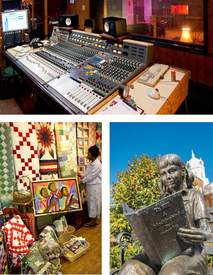 The mixing board at Muscle Shoals’s FAME studios (Robin McDonald); Quilts at Black Belt Treasures in Camden. (Alabama Tourism Department); A Celebration of Reading statue in Monroeville. (Alabama Tourism Department)
The mixing board at Muscle Shoals’s FAME studios (Robin McDonald); Quilts at Black Belt Treasures in Camden. (Alabama Tourism Department); A Celebration of Reading statue in Monroeville. (Alabama Tourism Department)
Alabama Makers: The Year of Alabama Makers
By Lee Sentell
Editor’s Note: Alabama Heritage is excited to introduce a new department, “Alabama Makers,” which will celebrate the craftsmen, artists, farmers, writers, musicians, and others who create from their soul to their hands. Alabama Tourism Department Director Lee Sentell has designated 2016 as “The Year of Alabama Makers” and will introduce this department. We acknowledge and thank Alfa Insurance Company for sponsoring “Alabama Makers.”
This new department explores the upcoming 2016 “Year of Alabama Makers,” which will recognize those who synthesize imagination, art, commerce, and manufacturing to produce items that highlight the many special talents of Alabama communities. Their work and handicrafts reflect the state’s diverse offerings and contributions, from music and literature to clothing and other hand-crafted items.
About the Author
Lee Sentell is the director of the Alabama Tourism Department and vice chair of the Alabama Bicentennial Commission. Alfa Insurance, sponsor of the “Alabama Makers” department in Alabama Heritage, is a Montgomery-based company committed to providing its family of customers with all of its life, auto, and home insurance needs.
Additional Information
For more information about “The Year of Alabama Makers,” visit: http://alabama.travel/
For more information about Southern Makers, visit: http://southernmakers.com/#southern-makers
Other makers featured in the article:
Lowe Mill ARTS & Entertainment: http://www.lowemill.net/
Black Belt Treasures Cultural Arts Center: http://www.blackbelttreasures.com/
Gulf Coast Arts Alliance Art Gallery: http://gulfcoastartsalliance.com/
Naked Art Gallery: http://www.nakedartusa.com/
Belle Chevre Goat Farm: https://www.bellechevre.com/
Fox Point Farm: https://www.facebook.com/foxpointfarmalabama/
Stone Hollow Farmstead: http://stonehollowfarmstead.com/
E.A.T. South: http://www.eatsouth.org/
FAME Studios: http://www.fame2.com/
Muscle Shoals Music Foundation/Muscle Shoals Sound Studio: http://www.msmusicfoundation.org/
Alabama Music Hall of Fame: http://www.alamhof.org/
Billy Reid: https://www.billyreid.com/
Gee’s Bend Quilters Collective: http://alabama.travel/places-to-go/gees-bend-quilters-collective
Lonnie Holley: https://www.facebook.com/LonnieHolley/
Thornton Dial: http://www.edlingallery.com/artist/thornton-dial
Harper Lee: http://www.harperlee.com/bio.htm ; also, see Alabama Heritage feature in issue #97
Truman Capote: http://www.encyclopediaofalabama.org/article/h-1115 ; also, see Alabama Heritage features in issue #113
Mark Childress: http://www.crazyinalabama.com/
The F. Scott and Zelda Fitzgerald Museum: http://www.thefitzgeraldmuseum.org/
By Lee Sentell
Editor’s Note: Alabama Heritage is excited to introduce a new department, “Alabama Makers,” which will celebrate the craftsmen, artists, farmers, writers, musicians, and others who create from their soul to their hands. Alabama Tourism Department Director Lee Sentell has designated 2016 as “The Year of Alabama Makers” and will introduce this department. We acknowledge and thank Alfa Insurance Company for sponsoring “Alabama Makers.”
This new department explores the upcoming 2016 “Year of Alabama Makers,” which will recognize those who synthesize imagination, art, commerce, and manufacturing to produce items that highlight the many special talents of Alabama communities. Their work and handicrafts reflect the state’s diverse offerings and contributions, from music and literature to clothing and other hand-crafted items.
About the Author
Lee Sentell is the director of the Alabama Tourism Department and vice chair of the Alabama Bicentennial Commission. Alfa Insurance, sponsor of the “Alabama Makers” department in Alabama Heritage, is a Montgomery-based company committed to providing its family of customers with all of its life, auto, and home insurance needs.
Additional Information
For more information about “The Year of Alabama Makers,” visit: http://alabama.travel/
For more information about Southern Makers, visit: http://southernmakers.com/#southern-makers
Other makers featured in the article:
Lowe Mill ARTS & Entertainment: http://www.lowemill.net/
Black Belt Treasures Cultural Arts Center: http://www.blackbelttreasures.com/
Gulf Coast Arts Alliance Art Gallery: http://gulfcoastartsalliance.com/
Naked Art Gallery: http://www.nakedartusa.com/
Belle Chevre Goat Farm: https://www.bellechevre.com/
Fox Point Farm: https://www.facebook.com/foxpointfarmalabama/
Stone Hollow Farmstead: http://stonehollowfarmstead.com/
E.A.T. South: http://www.eatsouth.org/
FAME Studios: http://www.fame2.com/
Muscle Shoals Music Foundation/Muscle Shoals Sound Studio: http://www.msmusicfoundation.org/
Alabama Music Hall of Fame: http://www.alamhof.org/
Billy Reid: https://www.billyreid.com/
Gee’s Bend Quilters Collective: http://alabama.travel/places-to-go/gees-bend-quilters-collective
Lonnie Holley: https://www.facebook.com/LonnieHolley/
Thornton Dial: http://www.edlingallery.com/artist/thornton-dial
Harper Lee: http://www.harperlee.com/bio.htm ; also, see Alabama Heritage feature in issue #97
Truman Capote: http://www.encyclopediaofalabama.org/article/h-1115 ; also, see Alabama Heritage features in issue #113
Mark Childress: http://www.crazyinalabama.com/
The F. Scott and Zelda Fitzgerald Museum: http://www.thefitzgeraldmuseum.org/
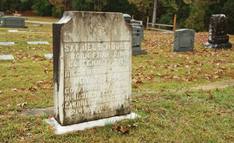 : In 1918 the local Masonic society erected a modest monument to Governor Moore in the Carrollton Cemetery. (Robin McDonald)
: In 1918 the local Masonic society erected a modest monument to Governor Moore in the Carrollton Cemetery. (Robin McDonald)
Alabama Governors
Samuel B. Moore (March – November 1831)
By Samuel L. Webb
Although his tenure as governor was brief, as he accepted the role upon his predecessor’s resignation near the end of his term, Samuel B. Moore took stands on several significant issues and even helped inaugurate the new University of Alabama as it welcomed its first class of students.
About the Author
Samuel L. Webb holds a JD from the University of Alabama School of Law and a PhD in history from the University of Arkansas. This department is drawn from Alabama Governors: A Political History of the State, Second Edition, edited by Webb and Margaret E. Armbrester.
Additional Information
For more information about Samuel B. Moore, see the article at the Encyclopedia of Alabama website: http://www.encyclopediaofalabama.org/article/h-1532
Samuel B. Moore (March – November 1831)
By Samuel L. Webb
Although his tenure as governor was brief, as he accepted the role upon his predecessor’s resignation near the end of his term, Samuel B. Moore took stands on several significant issues and even helped inaugurate the new University of Alabama as it welcomed its first class of students.
About the Author
Samuel L. Webb holds a JD from the University of Alabama School of Law and a PhD in history from the University of Arkansas. This department is drawn from Alabama Governors: A Political History of the State, Second Edition, edited by Webb and Margaret E. Armbrester.
Additional Information
For more information about Samuel B. Moore, see the article at the Encyclopedia of Alabama website: http://www.encyclopediaofalabama.org/article/h-1532
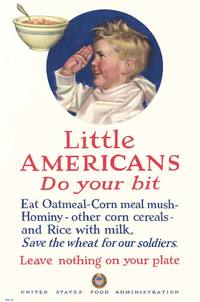 Examples of posters issued by various government agencies include this one from the United States Food Administration. (Alabama Department of Archives and History)
Examples of posters issued by various government agencies include this one from the United States Food Administration. (Alabama Department of Archives and History)
From the Archives
The Art of the Great War
By Keri Hallford
Art of the Great War, a new exhibit at the Museum of Alabama until early 2016, showcases highlights from the Alabama Department of Archives and History (ADAH) collection of World War I posters. These posters—which strove to boost morale on the home front, encourage civilians to conserve resources, and remind everyday Americans of the sacrifices being made abroad and at home—were created by many significant designers and artists throughout the United States, and the ADAH collection is particularly rich in its depth and diversity.
About the Author
Keri Hallford is the archivist of oversized collections for the Alabama Department of Archives and History. She received an MS in library and information studies from Florida State University and a BA in history with a minor in art history from Auburn University. She lives in Opelika, Alabama, with her husband and two beloved mutts.
Additional Information
For more information about the Museum of Alabama, visit: http://www.museum.alabama.gov/
“The Posters that Sold World War I to the American Public” (Smithsonian.com article) http://www.smithsonianmag.com/history/posters-sold-world-war-i-american-public-180952179/?no-ist
More posters at the Library of Congress: http://www.loc.gov/pictures/collection/wwipos/
The Art of the Great War
By Keri Hallford
Art of the Great War, a new exhibit at the Museum of Alabama until early 2016, showcases highlights from the Alabama Department of Archives and History (ADAH) collection of World War I posters. These posters—which strove to boost morale on the home front, encourage civilians to conserve resources, and remind everyday Americans of the sacrifices being made abroad and at home—were created by many significant designers and artists throughout the United States, and the ADAH collection is particularly rich in its depth and diversity.
About the Author
Keri Hallford is the archivist of oversized collections for the Alabama Department of Archives and History. She received an MS in library and information studies from Florida State University and a BA in history with a minor in art history from Auburn University. She lives in Opelika, Alabama, with her husband and two beloved mutts.
Additional Information
For more information about the Museum of Alabama, visit: http://www.museum.alabama.gov/
“The Posters that Sold World War I to the American Public” (Smithsonian.com article) http://www.smithsonianmag.com/history/posters-sold-world-war-i-american-public-180952179/?no-ist
More posters at the Library of Congress: http://www.loc.gov/pictures/collection/wwipos/
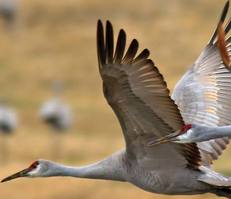 Rebounding from fewer than 500 birds in the eastern US in the early 1960s to more than 55,000 today, the magnificent Sandhill Crane is now a regular winter resident at Wheeler NWR. (George Lee)
Rebounding from fewer than 500 birds in the eastern US in the early 1960s to more than 55,000 today, the magnificent Sandhill Crane is now a regular winter resident at Wheeler NWR. (George Lee)
Portraits and Landscapes
The Return of the Cranes
By Thomas V. Ress
Amid the many conservation issues plaguing animal and plant species worldwide, one success story travels right through Alabama—that of the Sandhill and Whooping Cranes, which now spend part of their winter migration in sites such as Wheeler National Wildlife Refuge (NWR). Although the birds are still rare—fewer than 500 Whooping Cranes remain in the wild—their winter stopover in northern Alabama remains a significant part of their continued survival, and each year Wheeler NWR celebrates their presence through the Festival of the Cranes.
About the Author
Thomas V. Ress lives in Athens, Alabama. He is a prolific writer and avid adventurer and has visited six continents, dozens of countries, and all fifty states. His work has appeared in numerous national magazines, websites, and newspapers, and he loves hiking, biking, motorcycling, birding, and running.
Additional Information
For information on the 2016 Festival of the Cranes, please see the Wheeler NWR website:
http://www.fws.gov/nwrs/threecolumn.aspx?id=2147530985
The Return of the Cranes
By Thomas V. Ress
Amid the many conservation issues plaguing animal and plant species worldwide, one success story travels right through Alabama—that of the Sandhill and Whooping Cranes, which now spend part of their winter migration in sites such as Wheeler National Wildlife Refuge (NWR). Although the birds are still rare—fewer than 500 Whooping Cranes remain in the wild—their winter stopover in northern Alabama remains a significant part of their continued survival, and each year Wheeler NWR celebrates their presence through the Festival of the Cranes.
About the Author
Thomas V. Ress lives in Athens, Alabama. He is a prolific writer and avid adventurer and has visited six continents, dozens of countries, and all fifty states. His work has appeared in numerous national magazines, websites, and newspapers, and he loves hiking, biking, motorcycling, birding, and running.
Additional Information
For information on the 2016 Festival of the Cranes, please see the Wheeler NWR website:
http://www.fws.gov/nwrs/threecolumn.aspx?id=2147530985
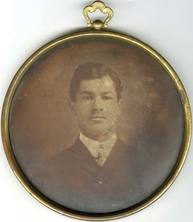 Items from the Schaudies-Banks-Ragland Collection include an 1866 tintype of Matthew H. Banks.
Items from the Schaudies-Banks-Ragland Collection include an 1866 tintype of Matthew H. Banks.
Revealing Hidden Collections
Inherited Histories: A North Alabama Clergyman’s Passion
By Mary Bess Kirksey Paluzzi
Often archival documents arrive at institutions in circuitous ways. The Schaudies-Banks-Ragland Collection at the University of Alabama is no exception. This collection, which explores African American life and culture in the nineteenth and twentieth century, arrived at the university after an inquiry about another item in the library’s archive sparked a clergyman’s interest in how best to preserve and pass on the documents and other items in his care.
About the Author
Mary Bess Kirksey Paluzzi recently retired as the associate dean for Special Collections at the University of Alabama. She has worked in the field of museums, library special collections, and archives for more than forty years.
Additional Information
For more information about the W. S. Hoole Special Collections library, visit: https://www.lib.ua.edu/libraries/hoole/
Inherited Histories: A North Alabama Clergyman’s Passion
By Mary Bess Kirksey Paluzzi
Often archival documents arrive at institutions in circuitous ways. The Schaudies-Banks-Ragland Collection at the University of Alabama is no exception. This collection, which explores African American life and culture in the nineteenth and twentieth century, arrived at the university after an inquiry about another item in the library’s archive sparked a clergyman’s interest in how best to preserve and pass on the documents and other items in his care.
About the Author
Mary Bess Kirksey Paluzzi recently retired as the associate dean for Special Collections at the University of Alabama. She has worked in the field of museums, library special collections, and archives for more than forty years.
Additional Information
For more information about the W. S. Hoole Special Collections library, visit: https://www.lib.ua.edu/libraries/hoole/
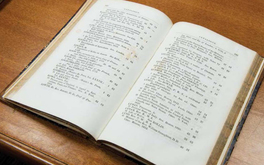 Six copies of the Catalogue are in the University Library’s collection. (Photo by Robin McDonald; W. S. Hoole Special Collections Library, the University of Alabama)
Six copies of the Catalogue are in the University Library’s collection. (Photo by Robin McDonald; W. S. Hoole Special Collections Library, the University of Alabama)
Alabama Treasures
The Book Catalogue of 1848: A Time Capsule to the History of the University of Alabama
By John H. Sandy
In the early years of the University of Alabama (UA), school officials endeavored to establish its credibility as an institution of higher learning on the frontier. One effort was rooted in The Catalogue of the Library of the University of Alabama With an Index of Subjects, a list of all the books held in the UA library system. With the university’s destruction at the hands of Union raiders during the Civil War, the book catalogue’s existence in other institutions remained even more valuable, as it helped preserve records of the texts that had once constituted the UA library.
About the Author
John H. Sandy is head of the Rodgers Library for Science and Engineering at the University of Alabama in Tuscaloosa
Additional Information
The University of Alabama library system contains six copies of the Book Catalogue of 1848. For more information about this book, see https://www.lib.ua.edu/
The Book Catalogue of 1848: A Time Capsule to the History of the University of Alabama
By John H. Sandy
In the early years of the University of Alabama (UA), school officials endeavored to establish its credibility as an institution of higher learning on the frontier. One effort was rooted in The Catalogue of the Library of the University of Alabama With an Index of Subjects, a list of all the books held in the UA library system. With the university’s destruction at the hands of Union raiders during the Civil War, the book catalogue’s existence in other institutions remained even more valuable, as it helped preserve records of the texts that had once constituted the UA library.
About the Author
John H. Sandy is head of the Rodgers Library for Science and Engineering at the University of Alabama in Tuscaloosa
Additional Information
The University of Alabama library system contains six copies of the Book Catalogue of 1848. For more information about this book, see https://www.lib.ua.edu/
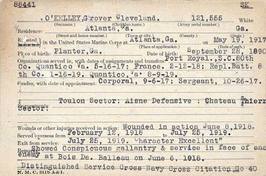 Despite records showing Sgt. O’Kelley exited from service on February 25, 1919, Marine Corps records persisted in declaring him killed in action in June 1918. (Samford University Archives)
Despite records showing Sgt. O’Kelley exited from service on February 25, 1919, Marine Corps records persisted in declaring him killed in action in June 1918. (Samford University Archives)
Adventures in Genealogy
The Search for Grover O’Kelley
By Elizabeth Crabtree Wells
Archivists and family members often rely on hard work, resources from other institutions or researchers, and even a bit of luck in tracking down stories about ancestors. Elizabeth Crabtree Wells, archivist at Samford University, explains the difficulty of piecing together one particularly challenging history—that of Grover O’Kelley, whose history was obscured thanks to a tragedy an adoption, and a major error in military records.
From the Editors: Looking for O’Kelley was a puzzle that had more gaps than pieces. If you are looking for members of the military, use all military records (enlistment, service, and other related records), but as with all records, read thoroughly for every fact. Other helpful resources for tracking down a subject include contacting an educational institution’s archives for enrollment or attendance records; schools may also have catalogs, yearbooks, or school newspapers. City directories assist in following people through the years with data about spouses, addresses, and professions. Also, make sure you recheck your sources after finding clues—what you found earlier may make more sense and add another piece to the puzzle.
About the Author
Elizabeth Crabtree Wells has been the processing archivist in the special collection and archives department of Samford University’s library since 2013, after serving as the department chair for thirty-eight years. She is a co-editor of this department with Yvonne Shelton Crumpler, who retired in 2008 from the Tutwiler Collection of Southern History and Literature, where she had worked as a research librarian in special collections for thirty-four years. Department sponsor, HudsonAlpha Institute for Biotechnology, is a global leader in DNA research.
Additional Information
For more information about Grover O’Kelley, please see: http://marines.togetherweserved.com/usmc/servlet/tws.webapp.WebApp?cmd=ShadowBoxProfile&type=Person&ID=398526
FamilySearch.org Genealogy Tips for Military Records:
https://familysearch.org/learn/wiki/en/United_States_Military_Records
Research Military Records at the National Archives: https://www.archives.gov/research/military/
The Search for Grover O’Kelley
By Elizabeth Crabtree Wells
Archivists and family members often rely on hard work, resources from other institutions or researchers, and even a bit of luck in tracking down stories about ancestors. Elizabeth Crabtree Wells, archivist at Samford University, explains the difficulty of piecing together one particularly challenging history—that of Grover O’Kelley, whose history was obscured thanks to a tragedy an adoption, and a major error in military records.
From the Editors: Looking for O’Kelley was a puzzle that had more gaps than pieces. If you are looking for members of the military, use all military records (enlistment, service, and other related records), but as with all records, read thoroughly for every fact. Other helpful resources for tracking down a subject include contacting an educational institution’s archives for enrollment or attendance records; schools may also have catalogs, yearbooks, or school newspapers. City directories assist in following people through the years with data about spouses, addresses, and professions. Also, make sure you recheck your sources after finding clues—what you found earlier may make more sense and add another piece to the puzzle.
About the Author
Elizabeth Crabtree Wells has been the processing archivist in the special collection and archives department of Samford University’s library since 2013, after serving as the department chair for thirty-eight years. She is a co-editor of this department with Yvonne Shelton Crumpler, who retired in 2008 from the Tutwiler Collection of Southern History and Literature, where she had worked as a research librarian in special collections for thirty-four years. Department sponsor, HudsonAlpha Institute for Biotechnology, is a global leader in DNA research.
Additional Information
For more information about Grover O’Kelley, please see: http://marines.togetherweserved.com/usmc/servlet/tws.webapp.WebApp?cmd=ShadowBoxProfile&type=Person&ID=398526
FamilySearch.org Genealogy Tips for Military Records:
https://familysearch.org/learn/wiki/en/United_States_Military_Records
Research Military Records at the National Archives: https://www.archives.gov/research/military/
Reading the Southern Past
The Tennessee Valley in War and Peace
By Stephen Goldfarb
This quarter’s installment explores the development of the Tennessee Valley in different eras, taking as its subjects Transforming the Cotton Frontier: Madison County, Alabama, 1800–1840 (Louisiana State University Press, 1997) by Daniel S. Dupre; War’s Desolating Scourge: The Union’s Occupation of North Alabama (University Press of Kansas, 2012) by Joseph W. Danielson; and Transforming the South: Federal Development in the Tennessee Valley, 1915-1960 (Louisiana State University Press, 2014) by Matthew L. Downs (who was a regular contributor to Alabama Heritage’s “Becoming Alabama” department during its tenure).
About the Author
Stephen Goldfarb holds a PhD in the history of science and technology. He retired from a public library in 2003.
Additional Information
Transforming the Cotton Frontier: Madison County, Alabama, 1800 – 1840 (Louisiana State University Press, 1997), by Daniel S. Dupre: http://lsupress.org/books/detail/transforming-the-cotton-frontier/
Transforming the South: Federal Development in the Tennessee Valley, 1915 – 1960 (Louisiana State University Press, 2014), by Matthew L. Downs: http://lsupress.org/books/detail/transforming-the-south/
War’s Desolating Scourge: The Union’s Occupation of North Alabama (University Press of Kansas, 2012), by Joseph W. Danielson: https://kuecprd.ku.edu/~upress/cgi-bin/978-0-7006-1844-6.html
The Tennessee Valley in War and Peace
By Stephen Goldfarb
This quarter’s installment explores the development of the Tennessee Valley in different eras, taking as its subjects Transforming the Cotton Frontier: Madison County, Alabama, 1800–1840 (Louisiana State University Press, 1997) by Daniel S. Dupre; War’s Desolating Scourge: The Union’s Occupation of North Alabama (University Press of Kansas, 2012) by Joseph W. Danielson; and Transforming the South: Federal Development in the Tennessee Valley, 1915-1960 (Louisiana State University Press, 2014) by Matthew L. Downs (who was a regular contributor to Alabama Heritage’s “Becoming Alabama” department during its tenure).
About the Author
Stephen Goldfarb holds a PhD in the history of science and technology. He retired from a public library in 2003.
Additional Information
Transforming the Cotton Frontier: Madison County, Alabama, 1800 – 1840 (Louisiana State University Press, 1997), by Daniel S. Dupre: http://lsupress.org/books/detail/transforming-the-cotton-frontier/
Transforming the South: Federal Development in the Tennessee Valley, 1915 – 1960 (Louisiana State University Press, 2014), by Matthew L. Downs: http://lsupress.org/books/detail/transforming-the-south/
War’s Desolating Scourge: The Union’s Occupation of North Alabama (University Press of Kansas, 2012), by Joseph W. Danielson: https://kuecprd.ku.edu/~upress/cgi-bin/978-0-7006-1844-6.html
